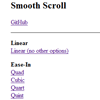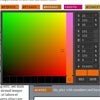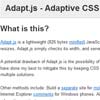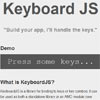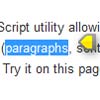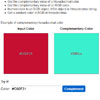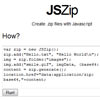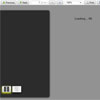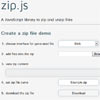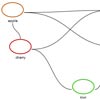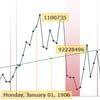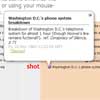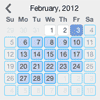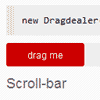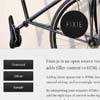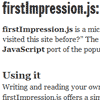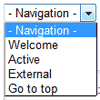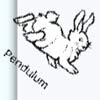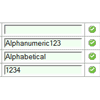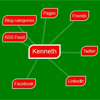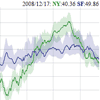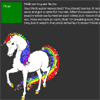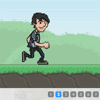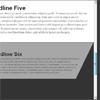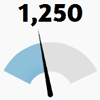Smooth Scroll 
A lightweight script to animate scrolling to anchor links. Smooth Scroll works great with Gumshoe.
Getting Started | Scroll Speed | Easing Options | API | What's new? | Known Issues | Browser Compatibility | License
Quick aside: you might not need this library. There's a native CSS way to handle smooth scrolling that might fit your needs.
Want to learn how to write your own vanilla JS plugins? Check out my Vanilla JS Pocket Guides or join the Vanilla JS Academy and level-up as a web developer. 🚀
Getting Started
Compiled and production-ready code can be found in the dist directory. The src directory contains development code.
1. Include Smooth Scroll on your site.
There are two versions of Smooth Scroll: the standalone version, and one that comes preloaded with polyfills for closest(), requestAnimationFrame(), and CustomEvent(), which are only supported in newer browsers.
If you're including your own polyfills or don't want to enable this feature for older browsers, use the standalone version. Otherwise, use the version with polyfills.
Direct Download
You can download the files directly from GitHub.
<script src="path/to/smooth-scroll.polyfills.min.js"></script>CDN
You can also use the jsDelivr CDN. I recommend linking to a specific version number or version range to prevent major updates from breaking your site. Smooth Scroll uses semantic versioning.
<!-- Always get the latest version --> <!-- Not recommended for production sites! --> <script src="https://cdn.jsdelivr.net/gh/cferdinandi/smooth-scroll/dist/smooth-scroll.polyfills.min.js"></script> <!-- Get minor updates and patch fixes within a major version --> <script src="https://cdn.jsdelivr.net/gh/cferdinandi/smooth-scroll@15/dist/smooth-scroll.polyfills.min.js"></script> <!-- Get patch fixes within a minor version --> <script src="https://cdn.jsdelivr.net/gh/cferdinandi/[email protected]/dist/smooth-scroll.polyfills.min.js"></script> <!-- Get a specific version --> <script src="https://cdn.jsdelivr.net/gh/cferdinandi/[email protected]/dist/smooth-scroll.polyfills.min.js"></script>NPM
You can also use NPM (or your favorite package manager).
npm install smooth-scroll2. Add the markup to your HTML.
No special markup needed—just standard anchor links. Give the anchor location an ID just like you normally would.
<a data-scroll href="#bazinga">Anchor Link</a> ... <div id="bazinga">Bazinga!</div>Note: Smooth Scroll does not work with <a name="anchor"></a> style anchors. It requires IDs.
3. Initialize Smooth Scroll.
In the footer of your page, after the content, initialize Smooth Scroll by passing in a selector for the anchor links that should be animated. And that's it, you're done. Nice work!
<script> var scroll = new SmoothScroll('a[href*="#"]'); </script>Note: The a[href*="#"] selector will apply Smooth Scroll to all anchor links. You can selectively target links using any other selector(s) you'd like. Smooth Scroll accepts multiple selectors as a comma separated list. Example: '.js-scroll, [data-scroll], #some-link'.
Scroll Speed
Smooth Scroll allows you to adjust the speed of your animations with the speed option.
This a number representing the amount of time in milliseconds that it should take to scroll 1000px. Scroll distances shorter than that will take less time, and scroll distances longer than that will take more time. The default is 300ms.
var scroll = new SmoothScroll('a[href*="#"]', { speed: 300 });If you want all of your animations to take exactly the same amount of time (the value you set for speed), set the speedAsDuration option to true.
// All animations will take exactly 500ms var scroll = new SmoothScroll('a[href*="#"]', { speed: 500, speedAsDuration: true });Easing Options
Smooth Scroll comes with about a dozen common easing patterns. Here's a demo of the different patterns.
Linear Moves at the same speed from start to finish.
Linear
Ease-In Gradually increases in speed.
easeInQuadeaseInCubiceaseInQuarteaseInQuint
Ease-In-Out Gradually increases in speed, peaks, and then gradually slows down.
easeInOutQuadeaseInOutCubiceaseInOutQuarteaseInOutQuint
Ease-Out Gradually decreases in speed.
easeOutQuadeaseOutCubiceaseOutQuarteaseOutQuint
You can also pass in your own custom easing pattern using the customEasing option.
var scroll = new SmoothScroll('a[href*="#"]', { // Function. Custom easing pattern // If this is set to anything other than null, will override the easing option above customEasing: function (time) { // return <your formulate with time as a multiplier> // Example: easeInOut Quad return time < 0.5 ? 2 * time * time : -1 + (4 - 2 * time) * time; } });API
Smooth Scroll includes smart defaults and works right out of the box. But if you want to customize things, it also has a robust API that provides multiple ways for you to adjust the default options and settings.
Options and Settings
You can pass options and callbacks into Smooth Scroll when instantiating.
var scroll = new SmoothScroll('a[href*="#"]', { // Selectors ignore: '[data-scroll-ignore]', // Selector for links to ignore (must be a valid CSS selector) header: null, // Selector for fixed headers (must be a valid CSS selector) topOnEmptyHash: true, // Scroll to the top of the page for links with href="#" // Speed & Duration speed: 500, // Integer. Amount of time in milliseconds it should take to scroll 1000px speedAsDuration: false, // If true, use speed as the total duration of the scroll animation durationMax: null, // Integer. The maximum amount of time the scroll animation should take durationMin: null, // Integer. The minimum amount of time the scroll animation should take clip: true, // If true, adjust scroll distance to prevent abrupt stops near the bottom of the page offset: function (anchor, toggle) { // Integer or Function returning an integer. How far to offset the scrolling anchor location in pixels // This example is a function, but you could do something as simple as `offset: 25` // An example returning different values based on whether the clicked link was in the header nav or not if (toggle.classList.closest('.my-header-nav')) { return 25; } else { return 50; } }, // Easing easing: 'easeInOutCubic', // Easing pattern to use customEasing: function (time) { // Function. Custom easing pattern // If this is set to anything other than null, will override the easing option above // return <your formulate with time as a multiplier> // Example: easeInOut Quad return time < 0.5 ? 2 * time * time : -1 + (4 - 2 * time) * time; }, // History updateURL: true, // Update the URL on scroll popstate: true, // Animate scrolling with the forward/backward browser buttons (requires updateURL to be true) // Custom Events emitEvents: true // Emit custom events });Custom Events
Smooth Scroll emits three custom events:
scrollStartis emitted when the scrolling animation starts.scrollStopis emitted when the scrolling animation stops.scrollCancelis emitted if the scrolling animation is canceled.
All three events are emitted on the document element and bubble up. You can listen for them with the addEventListener() method. The event.detail object includes the anchor and toggle elements for the animation.
// Log scroll events var logScrollEvent = function (event) { // The event type console.log('type:', event.type); // The anchor element being scrolled to console.log('anchor:', event.detail.anchor); // The anchor link that triggered the scroll console.log('toggle:', event.detail.toggle); }; // Listen for scroll events document.addEventListener('scrollStart', logScrollEvent, false); document.addEventListener('scrollStop', logScrollEvent, false); document.addEventListener('scrollCancel', logScrollEvent, false);Methods
Smooth Scroll also exposes several public methods.
animateScroll()
Animate scrolling to an anchor.
var scroll = new SmoothScroll(); scroll.animateScroll( anchor, // Node to scroll to. ex. document.querySelector('#bazinga') toggle, // Node that toggles the animation, OR an integer. ex. document.querySelector('#toggle') options // Classes and callbacks. Same options as those passed into the init() function. );Example 1
var scroll = new SmoothScroll(); var anchor = document.querySelector('#bazinga'); scroll.animateScroll(anchor);Example 2
var scroll = new SmoothScroll(); var anchor = document.querySelector('#bazinga'); var toggle = document.querySelector('#toggle'); var options = { speed: 1000, easing: 'easeOutCubic' }; scroll.animateScroll(anchor, toggle, options);Example 3
// You can optionally pass in a y-position to scroll to as an integer var scroll = new SmoothScroll(); scroll.animateScroll(750);cancelScroll()
Cancel a scroll-in-progress.
var scroll = new SmoothScroll(); scroll.cancelScroll();Note: This does not handle focus management. The user will stop in place, and focus will remain on the anchor link that triggered the scroll.
destroy()
Destroy the current initialization. This is called automatically in the init method to remove any existing initializations.
var scroll = new SmoothScroll(); scroll.destroy();Fixed Headers
If you're using a fixed header, Smooth Scroll will automatically offset scroll distances by the header height. Pass in a valid CSS selector for your fixed header as an option to the init.
If you have multiple fixed headers, pass in the last one in the markup.
<nav data-scroll-header> ... </nav> ... <script> var scroll = new SmoothScroll('.some-selector',{ header: '[data-scroll-header]' }); </script>What's new?
Scroll duration now varies based on distance traveled. If you want to maintain the old scroll animation duration behavior, set the speedAsDuration option to true.
Known Issues
Reduce Motion Settings
This isn't really an "issue" so-much as a question I get a lot.
Smooth Scroll respects the Reduce Motion setting available in certain operating systems. In browsers that surface that setting, Smooth Scroll will not run and will revert to the default "jump to location" anchor link behavior.
I've decided to respect user preferences of developer desires here. This is not a configurable setting.
<body> styling
If the <body> element has been assigned a height of 100% or overflow: hidden, Smooth Scroll is unable to properly calculate page distances and will not scroll to the right location. The <body> element can have a fixed, non-percentage based height (ex. 500px), or a height of auto, and an overflow of visible.
Animating from the bottom
Animated scrolling links at the very bottom of the page (example: a "scroll to top" link) will stop animated almost immediately after they start when using certain easing patterns. This is an issue that's been around for a while and I've yet to find a good fix for it. I've found that easeOut* easing patterns work as expected, but other patterns can cause issues. See this discussion for more details.
Scrolling to an anchor link on another page
This, unfortunately, cannot be done well.
Most browsers instantly jump you to the anchor location when you load a page. You could use scrollTo(0, 0) to pull users back up to the top, and then manually use the animateScroll() method, but in my experience, it results in a visible jump on the page that's a worse experience than the default browser behavior.
Browser Compatibility
Smooth Scroll works in all modern browsers, and IE 9 and above.
Smooth Scroll is built with modern JavaScript APIs, and uses progressive enhancement. If the JavaScript file fails to load, or if your site is viewed on older and less capable browsers, anchor links will jump the way they normally would.
Note: Smooth Scroll will not run—even in supported browsers—if users have Reduce Motion enabled. Learn more in the "Known Issues" section.
Polyfills
Support back to IE9 requires polyfills for closest(), requestAnimationFrame(), and CustomEvent(). Without them, support starts with Edge.
Use the included polyfills version of Smooth Scroll, or include your own.
License
The code is available under the MIT License.
